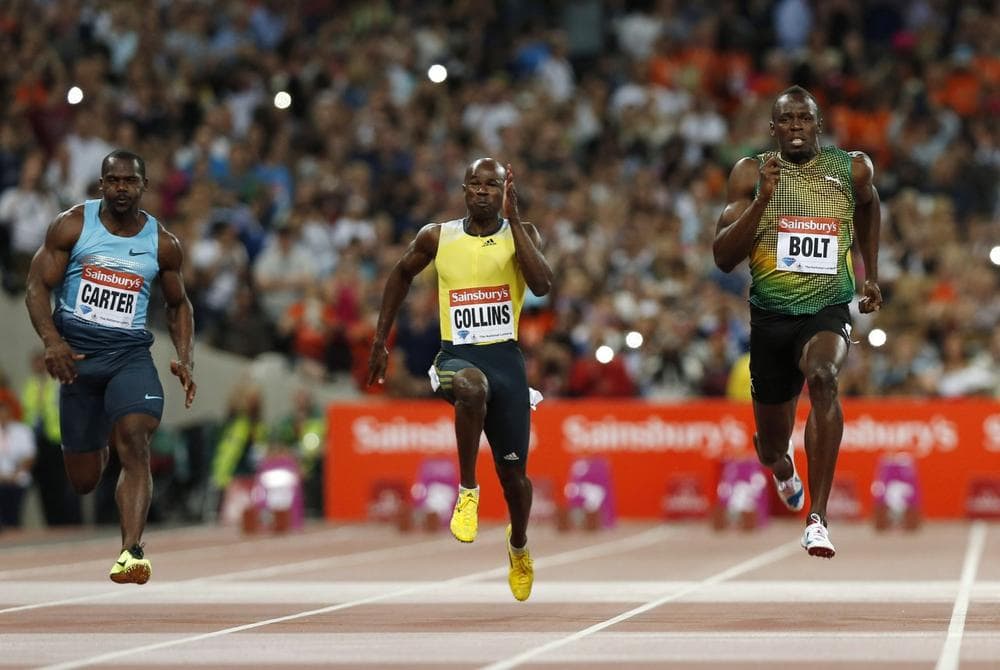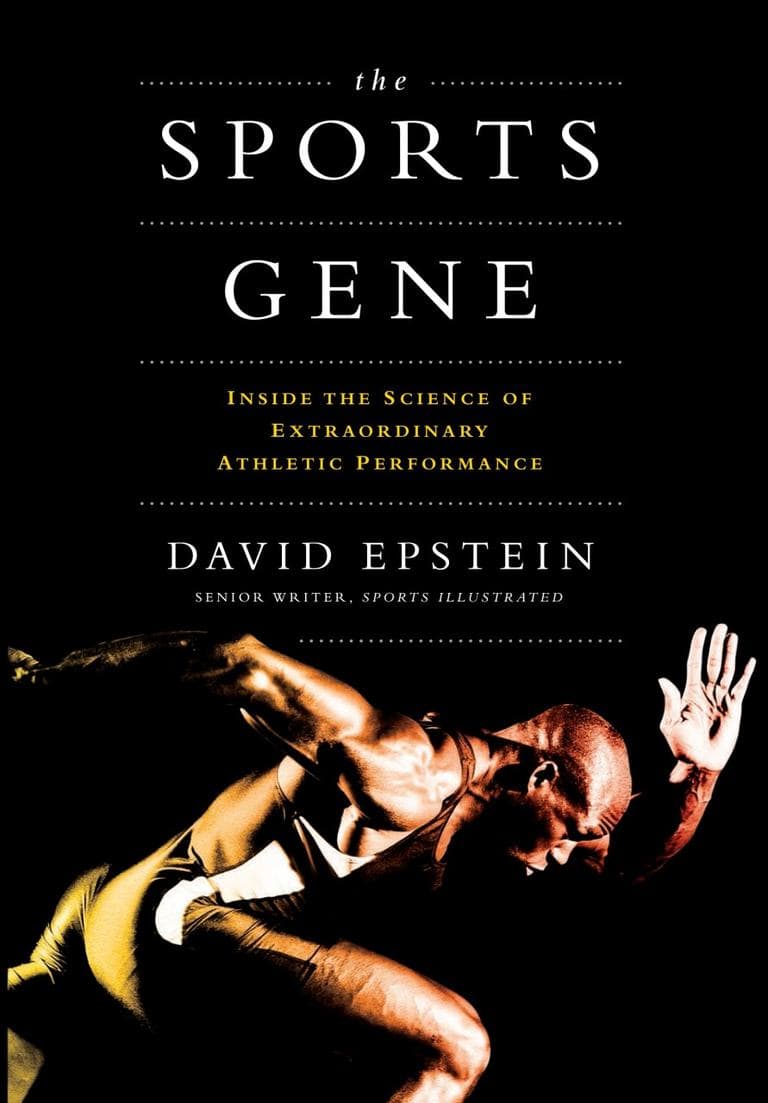Advertisement
Featured Book
'The Sports Gene' Explores The Science Of Success
Resume
While researching his new book The Sports Gene: Inside the Science of Extraordinary Athletic Performance, David Epstein traveled the world to talk with elite athletes and the scientists who study them. He found a complicated web of athletics, training, ancient folklore and debates about nature versus nurture.
Highlights From Doug's Interview With David Epstein
DT: There’s a long list of people offended by research into genetics in sports. You’ve got people who don’t want to hear their race is at an advantage, people who don’t want to hear they’re at a disadvantage, and there are elite athletes who don’t want a genetic fluke to get the credit for their hard work. How is that hindering the efforts of scientists who are trying to learn more?
DE: In two main ways. Some of the scientists I spoke with told me they would actually drop the word “genetics” from their scientific grant proposals and substitute it with something like “molecular biology and protein synthesis,” which is the exact same thing. It just doesn’t have that sort of deterministic air about it. And also, of course, there’s the tie to race, and some of the scientists are concerned that documenting any physical difference between ethnicities can somehow be taken to support the idea of innate intellectual differences even though the two have nothing to do with one another.
DT: There’s an old basketball adage that you can’t coach height, and that certainly still proves true in the NBA. But maybe a better adage would be, "You can’t coach wingspan?"
DE: When I analyzed data from the NBA combines next to [Centers for Disease Control] data on American height, I found an American man between the ages of 20 and 40 who’s at least 7-feet tall has about a 17 percent chance of being in the NBA right now, so that shows you how important height is. At the same time, most of these guys have extraordinarily long arm spans, even compared to their heights. So I’m about to 1:1 exactly – my arm span is the same as my height. Most people are a little longer than that, 1.01:1. In the NBA, the average is 1.05:1. So not only are these guys ludicrously tall, they’re preposterously long.
DT: According to one researcher’s projections, one in every 20 million men in the world have innate, world-class running talent. In Kenya, 1,600 in every 20 million have it. How do nature and nurture collide in Kenya’s Kalenjin region?
DE: I think Americans think of Kenyans as being great distance runners and marathoners. In Kenya, they think of the Kalenjin tribe as being the great runners. They only represent 10 - 12 percent of the population, but they happen to have very long, thin limbs. That’s an adaptation for cooling – same reason your radiator has long coils, to increase the surface area to the volume. And because the leg is a pendulum, having long, thin limbs makes it much more energy efficient to swing.
So you have this group of people, the Kalenjin, who have, on average, not talking about any individual, a body type conducive to running. And then you have this environment where they’re growing up at altitude, which increases the surface area of your lungs. They’re running to and from school, so they’re staying fit, they’re staying lean, they’re learning if they’re good at it. When I would go to the dirt tracks there, someone would walk off of a subsistence farm and try to run right alongside a guy with a gold medal, you know, on a dirt track with sheep grazing on the infield. So, you have this huge number of people who are basically giving it a shot, and not by jogging, really by training. There are no joggers in Kenya. There are only people who are running for transportation, people who are killing themselves in training to be an Olympian, and people who aren’t running at all. So you have a good talent pool and a great talent-sifting mechanism with a large group of people training.
 Doug's Review of The Sports Gene
Doug's Review of The Sports Gene
David Epstein logged a lot of miles to do the research for his new book, The Sports Gene: Inside the Science of Extraordinary Athletic Performance, and the results are fascinating. From an ophthalmologist who used eye exams to predict which baseball prospects would become major league stars to the amazing story of a somewhat disinterested endurance athlete who couldn’t help but become the best female competitor in Ironman history, Epstein delves into compelling stories from around the globe that tie into state-of-the-art genetic research.
Epstein likens the human genome to a 23,000-page recipe book that’s found in every human cell. Explaining the challenge of trying to figure out which genes lead to specific traits, he writes: “If one page is altered or torn out, then some of the other 22,999 pages may suddenly contain new instructions.”
The Sports Gene examines the value of intense training versus genetic good fortune. In his influential book, Outliers Malcolm Gladwell writes about a theory that 10,000 hours of practice could turn anyone into an elite performer in their chosen field. The idea has been so widely quoted since that there’s even a golfer who took up the game trying to make the PGA Tour after 10,000 hours of practice. Epstein reveals that the researcher behind that theory blames a chapter title in Gladwell’s book for creating a misunderstanding about the research. It turns out 10,000 hours is an average, not a hard and fast number, meaning some people might need more time -- a lot more time -- to achieve their goals.
In one chapter, Epstein explores the science behind Jamaican folklore that credits the island’s warrior-slave history for the current dominance of the nation's sprinters. The next chapter, titled “Malaria and Muscle Fibers,” details connections between malaria in western Africa, the sickle-cell trait, and elite short-distance runners. After that Epstein, looks at the phenomenon of Kenyan long-distance runners, noting that, according to one estimate, 80 in every 1 million Kenyan men have the foundation for world-class running talent. That figure is 1 in 20 million in the rest of the world. Those three chapters alone make reading The Sports Gene worthwhile.
To Epstein’s credit, in a book loaded with documentation and detail, there are only a couple of spots where the momentum lags with a bit of extended explanation. One example is the concept of “chunking,” which boils down to an elite athlete’s ability quickly assess a sports scenario after seeing just a glimpse of the situation. The research into the concept is certainly noteworthy, but not difficult to understand.
But that’s a minor blip in an immensely accessible and enjoyable book. One of Epstein’s strengths is his ability to remain devoted to a fair and thorough explanation of the science while weaving in great stories about athletes who exemplify the concept at hand. The Sports Gene is also dotted with funny, clever turns of phrase. In an excellent chapter, Epstein explains why having wingspans greater than their respective heights is nearly as important for NBA players as being tall. He describes sharpshooter J.J. Reddick’s perfectly normal wingspan (6’3¼” compared to Reddick’s height: 6’4”) as “downright Tyrannosaurus Rex-ian” by NBA standards.
Dog-earing interesting pages left my copy of The Sports Gene well worn. It’s a book that will give you a different way to think about the sports you watch and play.
This segment aired on August 17, 2013.
